Fermenting Beer with White Labs WLP351 Bavarian Weizen Ale Yeast
Published: October 14, 2025 at 7:52:11 PM UTC
WLP351 Bavarian Weizen Ale Yeast from White Labs is a top choice for brewers aiming to craft classic Weissbier and Weizenbock flavors. This Weissbier yeast is known for its medium to high spicy phenolic notes, reminiscent of cloves. It naturally complements wheat-forward grain bills.
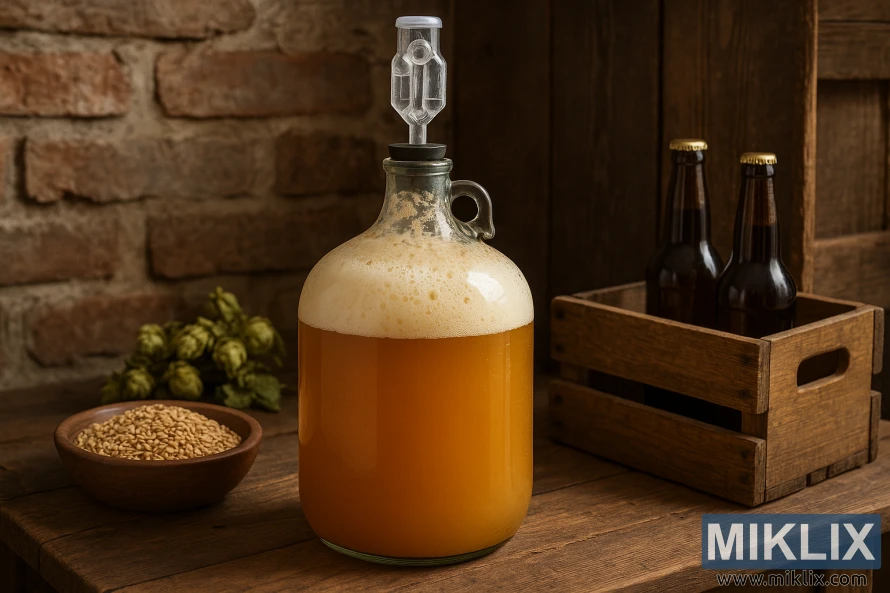
White Labs provides key specs for White Labs WLP351: attenuation 75–82%, low flocculation, and very high alcohol tolerance (15%+). The recommended fermentation temperature range is 66–70°F (19–21°C). These parameters make WLP351 a reliable choice for Bavarian weizen fermentation. They also allow brewers to shape esters and phenols through pitching and temperature choices.
Practical brewing notes support these specs. A common 5-gallon all-grain recipe uses one vial of WLP351. It ferments 2–3 weeks at about 68°F to reach an OG near 1.048 and FG around 1.013. Brewers note that open, shallow fermentation can alter the aroma profile. Thus, the choice between open and closed fermentation affects the final beer.
Key Takeaways
- WLP351 Bavarian Weizen Ale Yeast produces classic clove-like phenolics ideal for Weissbier.
- Recommended fermentation temperature is 66–70°F (19–21°C) for balanced character.
- Attenuation typically falls between 75–82% with very high alcohol tolerance.
- Pitching rates and open versus closed fermentation strongly influence flavor.
- One White Labs WLP351 vial is commonly used for a 5-gallon all-grain batch.
Why Choose WLP351 Bavarian Weizen Ale Yeast for Your Wheat Beer
WLP351 is renowned for its spicy, clove-like phenolics, essential for classic Weissbier and weizen profiles. It provides a solid base for German-style wheat beers. The flavor and aroma evolve with the pitching rate and fermentation temperature.
For Dunkelweizen and traditional Weissbier, professional recipes often combine WLP351 with specialty malts. This combination is key to achieving the desired color and taste in authentic Dunkelweizen and other dark wheat styles.
Homebrewers often use open fermentation or shallow vessels to enhance the yeast's character. This approach underscores the importance of Weissbier yeast selection for achieving the classic weizen flavor in Hefeweizen and Weizenbock.
- Medium to high spicy phenolic profile that suits traditional Bavarian beers.
- Responsive to underpitching for stronger style character.
- Well-suited to Weissbier yeast selection for both Hefe and Dunkel variants.
WLP351 is widely accepted in the industry and praised by homebrewers. It's the top choice for those seeking true Bavarian wheat yeast benefits and a classic weizen flavor.
Understanding Strain Specs: Fermentation Temperature and Alcohol Tolerance
WLP351 specs recommend a fermentation temperature of 66-70°F. This range is ideal for producing the classic banana and clove esters found in Bavarian wheat beers. It also ensures steady yeast activity. Brewers who maintain the wort at 68°F often achieve consistent results and reliable attenuation.
With an attenuation of 75-82%, WLP351 ferments a significant portion of available sugars. This results in a drier finish, which is beneficial for balancing malty or high-dextrin grain bills. For instance, an original gravity of 1.048 can decrease to a final gravity of 1.013 with full fermentation.
The yeast's alcohol tolerance of 15%+ offers brewers flexibility. It allows for brewing stronger styles like Weizenbock without harming the yeast culture. For traditional Weissbier, this high tolerance ensures against stuck fermentation, even with varying mash efficiency or fermentables.
WLP351 exhibits low flocculation, which means cells remain suspended longer. This aids in maintaining haze and mouthfeel. Fermentation trials reveal that vessel shape, headspace, and oxygen exposure can influence flavor, even within the 66-70°F temperature range. It's crucial to monitor fermentation activity and adjust temperature control or rouse the yeast if fermentation slows.
- Follow WLP351 specs for temperature and handling.
- Target fermentation temperature 66-70°F for reliable ester profile.
- Plan recipes with attenuation 75-82% in mind for final gravity expectations.
- Use the high alcohol tolerance 15%+ if you design stronger wheat beers.
Controlling temperature and vessel conditions is key to unlocking WLP351's full potential. Keeping records of time, temperature, and gravity helps correlate results with recipe choices and fermentation techniques.
Pitching Rates and How They Alter Flavor with WLP351
White Labs emphasizes the significant impact of WLP351 pitching rates on the aroma and taste of Bavarian wheat beers. Lower cell counts increase yeast stress, enhancing the clove-like phenolic character. Brewers aiming for a strong spice flavor often choose to underpitch intentionally.
Employ a yeast pitch calculator to determine the right cell count for your batch size and gravity. For a standard 5-gallon homebrew, many recipes suggest a single White Labs vial pitched at about 68°F after oxygenation. This approach usually achieves the desired attenuation and balances the Weissbier flavor.
Underpitching effects extend beyond just clove and spice. Stressed yeast can alter ester balance and fermentation vigor, impacting mouthfeel and perceived dryness. Prioritize sanitation and yeast health when experimenting with lower pitches, as stressed cells can lead to off-flavors if conditions deteriorate.
- Plan cell counts with a yeast pitch calculator to match gravity and temperature.
- For stronger phenolics, reduce the initial pitch but monitor fermentation closely.
- For cleaner Weissbier flavor control, increase the pitch or build a starter.
Timing and handling are crucial during the end of active fermentation. Consider vessel setup, spigot placement, and sampling or transfer logistics. These factors influence oxygen pickup and yeast suspension, affecting final flavor.
Practical experience from brewers indicates that a single vial pitched at recommended temperatures yields predictable attenuation. If you plan to experiment with WLP351 pitching rates, conduct small trials. Keep detailed logs of temperatures, gravity curves, and sensory results to refine your technique.
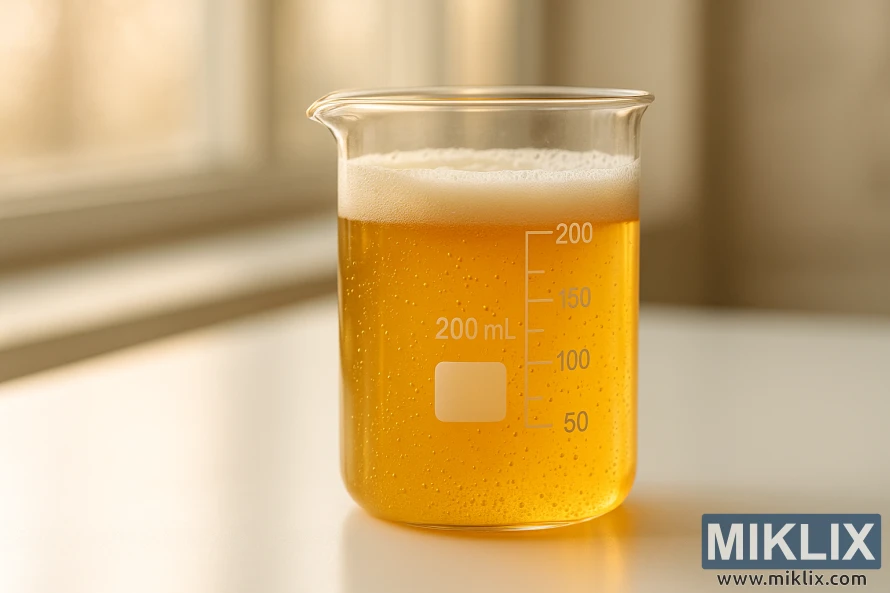
Open Fermentation vs Closed Fermentation for Weizenbeir
Deciding between open fermentation WLP351 and closed primary fermentation impacts aroma, flavor, and risk levels. White Labs explains that WLP351's response to pitching rate and temperature is influenced by the fermentation vessel choice. This choice determines how these factors manifest in the beer.
In Bavarian open fermentation, a shallow, wide vessel allows for greater yeast-air interaction. This interaction can enhance phenolics and esters, aligning with the traditional wheat beer profile. Brewers aiming for a rustic clove-banana flavor often opt for this method.
Closed fermentation weizen, on the other hand, is favored for its predictability. The Dunkel-er-Weisse method involves cooling to about 68°F, oxygenating, and pitching in a sealed primary. This approach is commonly adopted by craft breweries to manage off-flavors and contamination risks effectively.
Practical considerations are key. Open fermentation WLP351 can unveil subtle nuances but increases microbial exposure and handling requirements. In contrast, closed fermentation weizen minimizes these risks and streamlines transfer and bottling processes.
The choice of equipment significantly influences the outcome. An SS304 bucket modified with a spigot is ideal for near-complete transfers, suitable for both closed and shallow open fermentations. Larger conical fermenters, on the other hand, are better for closed fermentations, facilitating easier yeast harvesting. The decision hinges on your comfort level with risk and the desired flavor profile.
- Benefits of Bavarian open fermentation: enhanced yeast–air interaction and pronounced phenolics.
- Benefits of closed fermentation weizen: repeatability, lower contamination risk, easier temperature control.
- Considerations: sanitation, headspace, handling, and how WLP351 responds to pitch and temp.
Start by testing small batches with both methods to observe how WLP351 performs in your environment. Monitor gravity, aroma, and flavor during conditioning. This will help you determine which fermentation vessel choice aligns with your vision of the perfect weizen.
Recipe Guidelines: Grain Bills That Complement WLP351
WLP351 excels when wheat is the main focus in the grain bill. Aim for 50 to 70% wheat malt percentages for Weissbier or Weizenbock. This allows the yeast's banana and clove flavors to take center stage. It's crucial to keep specialty malts in check to ensure the yeast's character is not overshadowed.
In crafting a Dunkelweizen recipe, a robust wheat foundation paired with Vienna malt is essential. A blend of about 5 lb white wheat malt and roughly 4 lb Vienna malt forms a solid base. Adding small amounts of color and mouthfeel malts can refine the final appearance and texture.
- Introduce midnight wheat in only 0.5 lb to enhance color without introducing harsh roast flavors.
- Include 0.5 lb Carapils or similar to boost head retention and dextrins.
- Use Munich or darker malts sparingly to preserve the prominence of WLP351's phenolics.
When adjusting wheat malt percentages, remember that open fermentation can highlight subtle malt characteristics. Achieving balance is paramount: sufficient Vienna malt for malt sweetness, a hint of midnight wheat for color, and the majority from wheat to maintain the classic Weizen aroma.
Target sample gravity levels near OG 1.048 and FG 1.013 for a balanced body that showcases WLP351's characteristics. Make incremental adjustments to specialty additions to prevent masking the yeast's clove and banana notes.
Mashing and Mash Temperature Targets for Wheat Styles
Wheat beers are highly sensitive to mash temperature. A well-planned mash schedule for weizen is crucial for achieving the right body and fermentability. It ensures that WLP351 can fully express its unique characteristics.
For Bavarian-style wheat beers, mashing at 152-156°F for 60 minutes is common. Mashing at 152°F results in a more fermentable wort and a drier finish. On the other hand, mashing at 156°F retains more dextrins, leading to a fuller mouthfeel, ideal for richer weizenbocks.
Consistent mash thickness is key. Variations in mash thickness can disrupt enzyme balance and affect attenuation. Maintaining a stable mash temperature and time is essential to achieve the desired attenuation range, typically between 75–82% in practice.
Adopting a simple mash schedule for weizen can streamline the process. Start by resting at the saccharification target for 60 minutes, then raise to 170°F for mash out, and proceed with lautering. This approach ensures optimal enzymatic conversion and facilitates consistent results.
Even small adjustments in mash temperature can significantly impact the final gravity and the perceived yeast characteristics. For a more pronounced banana and clove flavor from WLP351, aim for the lower end of the mash range. This allows the yeast to consume more sugars. For a richer mouthfeel, increase the mash temperature towards 156°F to retain more dextrins.
It's vital to measure and record mash temperatures and volumes for each batch. Consistent practice leads to reliable dextrin retention and predictable results in mash temperature wheat beers across different brews.
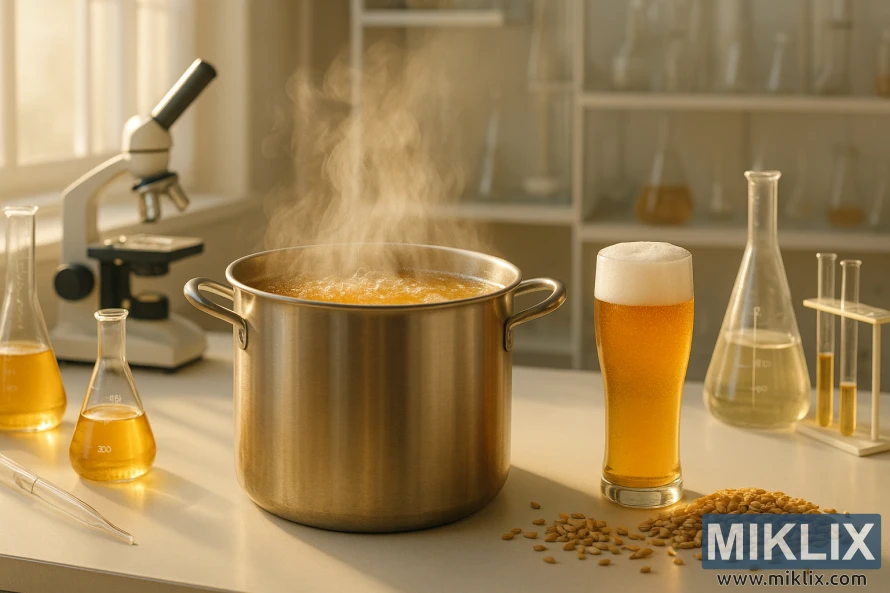
Wort Aeration and Nutrients When Using WLP351
Ensuring good aeration at pitch is crucial for WLP351's success. Brewers should oxygenate the wort just before adding yeast. This supports cell growth and enhances ester and phenol development. It's important to aim for the right dissolved oxygen levels, tailored to your system and batch size.
When using a single vial of WLP351 for five gallons, follow White Labs' guidance on pitch and temperature. This helps avoid stress on the yeast. If wort is not oxygenated enough or too late, the yeast may struggle, leading to off-flavors. Open fermentation can provide extra oxygen, beneficial for yeast health in weizen beers but demands strict sanitation.
Adding Servomyces yeast nutrient can help reduce stress during early fermentation. The Dunkel-er-Weisse method involves adding one capsule of Servomyces near the end of the boil. This timing ensures nutrients are bioavailable, supporting robust yeast growth when pitching WLP351.
- Oxygenate wort immediately after cooling and before pitching.
- Use proper pitch rate for WLP351 to match your target flavor profile.
- Add Servomyces yeast nutrient as recommended to aid yeast health for weizen.
- Consider open fermentation only if you can maintain sanitation while managing oxygen exposure.
Controlling oxygen levels and nutrient use allows WLP351 to express its classic weizen character without flaws. Simple steps at the beginning lead to cleaner, more consistent fermentations and better beer quality.
Fermentation Timeline and Temperature Control Strategies
Begin with a detailed WLP351 fermentation schedule to set clear expectations. White Labs suggests fermenting at 66-70°F for Bavarian weizen recipes. This temperature range is key to achieving the classic clove and banana flavors.
First, cool the wort to the ideal pitching temperature. Then, oxygenate the wort and pitch the yeast. Aim for a consistent temperature around 68°F during the active fermentation phase. A stable environment helps minimize fusel alcohols and keeps phenolics in balance.
For a 5-gallon Weizen or Dunkel-weisse, primary fermentation typically lasts 2-3 weeks. The first 3–5 days see vigorous activity, followed by a slower phase where esters and phenols mature.
Open fermentation requires closer monitoring. Shallow vessels can quickly transfer heat, so use ambient temperature control or a fermentation chamber. This helps maintain the desired 66-70°F range without sudden temperature fluctuations.
- Days 0–5: active krausen and most gravity drop. Hold ferment at 66-70°F.
- Days 6–14: slow attenuation and flavor development. Continue stable temperatures.
- Days 15–21: conditioning in primary. If clarity and flavor are clean, proceed to packaging.
Employ temperature probes and loggers to monitor progress. Small temperature adjustments can significantly impact the ester profile. Thus, precise temperature control is crucial for achieving the desired weizen style.
Monitoring Fermentation: Gravity, Activity, and When to Bottle
Track original gravity and calculate expected FG using WLP351's 75–82% attenuation. This sets clear targets for your brew. For an OG 1.048 batch, expect an FG near 1.012–1.015 for a classic weizen. Use these OG FG weizen numbers as a reference for planning conditioning and carbonation.
Watch fermentation activity signs closely during primary. WLP351 shows low flocculation, meaning krausen and haze stick around longer. A tall, persistent krausen and active bubbling are normal for two or more weeks.
Measure specific gravity at least twice, separated by 48–72 hours, to confirm stability before bottling. Brewers who bottle too early risk overcarbonation if gravity hasn’t stabilized. Best practice is to monitor fermentation WLP351 and wait for consistent readings.
Use sensory cues to supplement readings. Look for the rise and fall of krausen, reduced airlock bubbling, and clearing of the beer. These fermentation activity signs help decide if you should wait or move to the next step.
- Step 1: Record OG at transfer and calculate expected FG using attenuation ranges.
- Step 2: Take gravity readings after the first week and again after 48–72 hours to check stability.
- Step 3: Confirm visual fermentation activity signs have subsided before bottling.
If you plan to bottle-condition, use cane sugar and confirm gravity is stable over 2–3 days. For force carbonation, cold-crash and transfer after activity has ceased. Knowing when to bottle protects against overcarbonation and preserves flavor.
For a Dunkel-er-Weisse with OG 1.048 and target FG 1.013, expect primary fermentation to take 2–3 weeks with WLP351. Monitor fermentation WLP351 and rely on both OG FG weizen calculations and fermentation activity signs to time packaging with confidence.
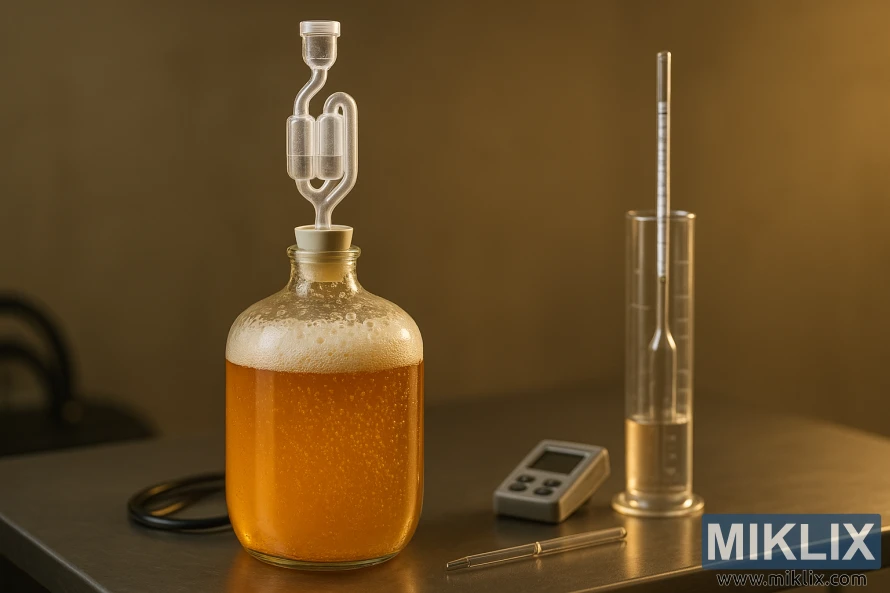
Conditioning and Carbonation Techniques for Weizen Styles
WLP351's low flocculation ensures yeast stays suspended, making bottle conditioning a reliable method for wheat beers. Allow gravity to settle for at least three days before transferring to bottles. This approach minimizes the risk of overcarbonation and bottle bombs.
To achieve a soft, creamy mouthfeel typical of Weissbier, bottle condition with cane sugar. Use a priming calculator to measure the sugar accurately. Distribute it evenly to prevent variations in carbonation levels between bottles.
For those who prefer more control, force carbonating weizen in a keg is an option. This method allows for precise carbonation levels, reaching the desired volumes for Weissbier without relying on secondary fermentation. Ensure all fittings are sanitized to maintain flavor purity.
Weissbier typically targets carbonation volumes near 3.0–4.0 volumes CO2. Higher carbonation enhances the beer's effervescence, lifting clove and banana esters and brightening the palate. Adjust the carbonation levels to suit your taste preferences and serving temperature.
- When bottle conditioning: use 4–6 grams cane sugar per 12 oz bottle as a starting point, based on your desired volumes and residual CO2.
- When force carbonating weizen: set the keg to the pressure table for 3.0–3.5 volumes at your serving temp, then carbonate over 24–72 hours.
- When bottling from open fermentation: ensure adequate yeast remains in suspension and avoid racking too cleanly; monitor gravity to confirm stability.
Store bottles at cellar temperatures for two weeks before chilling a test bottle. Chill conditioning aids yeast settling, resulting in a clearer pour. If the carbonation seems weak, return bottles to warmth for a few days to complete conditioning.
Label each batch with the priming method and target carbonation levels. This way, you can replicate successful batches. Whether you choose to bottle condition with cane sugar or force carbonate weizen, consistent methods lead to the lively carbonation that defines a great Weissbier.
Troubleshooting Common Issues with WLP351 Fermentations
WLP351 troubleshooting begins with the pitching rate and temperature. Underpitching can increase phenolic character, making the beer harsher. Overpitching, on the other hand, can mute the signature clove and banana notes. Aiming for a healthy pitch and fermenting at 66–70°F balances esters without harsh phenolics.
During active fermentation, watch for weizen off-flavors. If the beer smells medicinal, solventy, or overly phenolic, check yeast health and mash temperatures. Adjust future batches by increasing oxygenation at pitch and using appropriate yeast nutrients like Servomyces to support clean attenuation.
Stuck fermentation can occur when gravity stops short of target, such as an OG of 1.048 not reaching 1.013. Diagnose vitality, oxygen levels, and nutrient availability. Gentle rousing or warming by a few degrees may wake yeast. If progress does not resume, re-pitch a fresh, vigorous Saccharomyces yeast to finish fermentation.
Open fermentation offers classic aroma development but raises contamination risk. Scan for unusual pellicles, sour aromas, or unexpected film yeasts. If taints appear early, transfer to a clean fermenter and consider repitching to recover the batch when safe to do so.
Clarification can be tricky because WLP351 shows low to moderate flocculation. Plan filtration, fining, or extended conditioning to improve clarity. When bottling from a vessel with a drilled spigot, avoid drawing sediment that might lead to contamination or off-flavors in packaged beer.
- Checklist for quick fixes: confirm gravity and temperature, oxygenate at pitch, add nutrients if yeast seems sluggish, gently warm or rouse for stalled fermentations.
- Prevention tips: use a fresh, viable pack or starter, monitor fermentation daily, sanitize thoroughly for any open fermentation setup.
- When to re-pitch: after 48–72 hours of no activity and no change in gravity following warm rousing, consider a healthy starter of Sacramento or Nottingham strains to complete attenuation.
Keep logs of pitch rates, temps, and gravity readings. Clear notes speed WLP351 troubleshooting for future batches. Small adjustments yield cleaner results and preserve the classic wheat beer profile without unwanted weizen off-flavors.
Tasting Notes and Style Profiles You Can Expect
WLP351 tasting notes highlight a classic Bavarian weizen flavor profile. The beer has a soft, hazy appearance with a lively head. It also boasts moderate to bright carbonation, enhancing both aroma and mouthfeel.
Clove phenolics are a hallmark of this yeast. White Labs and many German brewers note medium to high spicy clove notes. This is true when fermentation occurs in the mid to upper temperature range. The balance between spice and fruit is influenced by pitch rate and temperature.
Banana esters emerge subtly when fermentation is warmer or when pitching rates are low. In such conditions, the banana esters remain secondary. This allows the clove phenolics to dominate the aroma.
For darker versions like Dunkel-er-Weisse, the yeast still showcases its signature phenolics. Malt complexity adds depth, with notes of roast and bread crust. A beer with roughly 4.6% ABV, 14 IBU, and a 40 SRM color will have a richer taste. The FG near 1.013 contributes to moderate body and a hint of sweetness if mashed warm.
Open fermentation can introduce delicate shifts in aromatics and mouthfeel. Brewers often report nuanced yeast expression. This includes a creamier texture and slightly more lifted ester perception compared to closed vessels.
- Appearance: hazy to cloudy, pale to copper depending on grain bill.
- Aroma: dominant clove phenolics, minor banana esters when warm.
- Mouthfeel: ranges from crisp to creamy based on mash temperature and conditioning.
- Finish: moderately dry with lingering spice and subtle fruity notes.
When crafting a recipe, adjust mash temperature, pitch rate, and fermentation management to achieve your desired WLP351 tasting notes. Cooler, swift ferments result in cleaner Bavarian weizen flavor. Warmer or slower profiles, on the other hand, bring more banana esters while preserving clove character.
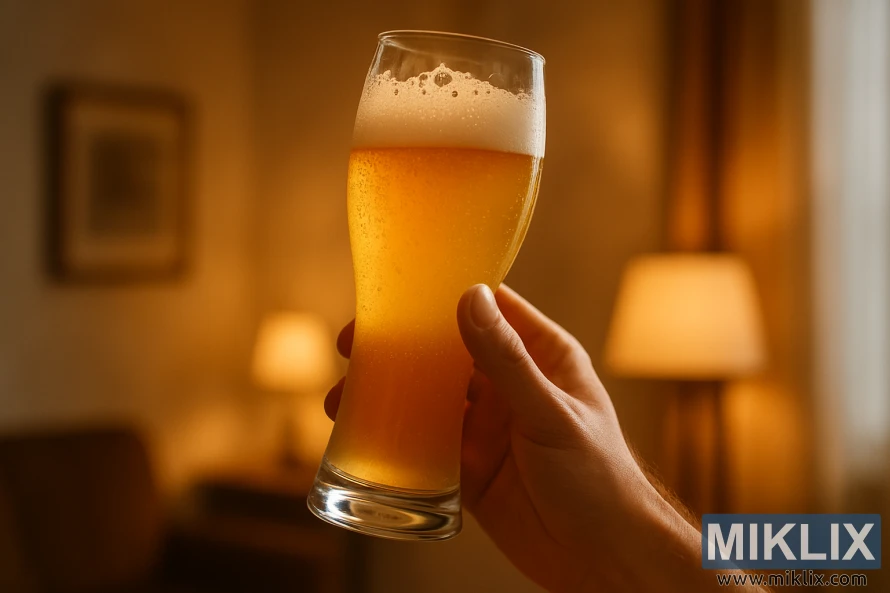
Scaling Recipes and Batch Size Considerations
Scaling WLP351 recipes from 5-gallon batches to larger volumes requires careful attention to pitching rate. White Labs advises that one vial is sufficient for a 5-gallon homebrew. Yet, as batch size or original gravity increases, so does the need for more vials per batch.
Higher gravity beers, such as Weizenbock, can stress yeast if underpitched, leading to intense phenolics. To avoid this, brewers often use a yeast starter for WLP351 or add multiple vials to achieve the desired cell count.
Planning is essential for pitching large batches. Utilize the White Labs pitch rate calculator or similar tools to estimate cell counts. Decide between a single large starter or multiple vials based on the required cell count.
- Estimate required cells by batch size and gravity.
- Choose a yeast starter for WLP351 when you need a fast ramp in cell numbers.
- Increase the number of vials per batch when time or equipment limits starter growth.
As batch volume increases, logistics become more complex. Cooling and oxygenation become more challenging. Select fermenters with good heat transfer or use glycol-chilled vessels. Properly manage pumping, racking, and sanitized fittings to minimize oxygen exposure and infection risk.
Temperature control is crucial in scaling WLP351 recipes. It influences the expression of phenolic and ester character. Accurate temperature control ensures consistent flavor across batches.
For large batches, plan transfer points and add racking taps or drilled spigots for easier handling. Effective pitching for large batches requires both the correct cell count and a smooth workflow during brew day and fermentation.
Monitor outcomes and adjust the number of vials per batch or the size of your yeast starter for WLP351 over successive brews. This will help achieve consistent OG/FG results and the desired flavor profile.
Where to Buy and Storage Recommendations for WLP351
White Labs lists WLP351 as a core strain with part number WLP351 and a clear buy now option on its product page. You can find White Labs WLP351 purchase options direct from White Labs and through authorized homebrew retailers that sell vials and liquid yeast packs.
Many homebrew suppliers stock WLP351 in single vials suitable for standard 5-gallon batches. When you buy WLP351, consider ordering cold shipping during warm months. Retailers often note product QC details such as STA1 positivity and batch numbers on their listings.
Yeast viability is crucial for fermentation performance. For an older vial or a high-gravity recipe, making a starter is advisable. If planning a White Labs WLP351 purchase for larger batches, factor in extra cells or multiple vials.
Proper yeast storage is key to preserving viability and flavor. Store yeast refrigerated from receipt until use. Follow White Labs guidance and avoid freezing liquid yeast, which can damage cells and reduce attenuation.
When your shipment arrives, check the vial date and refrigerate immediately. If delivery was delayed or warm, assess the vial age and appearance before pitching. Making a starter is a prudent step when viability is uncertain.
For long-term handling, keep vials upright and cold. Use yeast within the recommended window printed on the package. Careful yeast storage and timely pitching will improve fermentation reliability and the final beer quality.
Conclusion
WLP351 stands out as a top choice for brewers aiming for authentic Bavarian wheat flavors. White Labs' specifications, including high attenuation and low flocculation, align perfectly with the desired clove-forward phenolics and clean finish. This review combines lab data with real-world brewing experiences.
Practical brewing insights highlight the importance of pitching rate and temperature. A lower pitching rate and fermentation in the mid-60s to high-60s accentuates phenolic complexity. On the other hand, a healthy pitch and warmer temperatures enhance esters and faster attenuation. Homebrew experiments, such as Dunkel-er-Weisse at 68°F, demonstrate consistent OG-to-FG drops and ABVs near 4.6%, making WLP351 ideal for Weissbier and stronger weizen styles.
Open fermentation can introduce additional complexity but demands strict hygiene and careful oxygen management. For most homebrewers, closed fermentation with precise temperature control yields consistent outcomes. In summary, this review solidifies WLP351 as a premier wheat yeast for those seeking flexibility, authenticity, and the reliable performance documented by White Labs.
Further Reading
If you enjoyed this post, you may also like these suggestions:
- Fermenting Beer with Bulldog B1 Universal Ale Yeast
- Fermenting Beer with CellarScience Hazy Yeast
- Fermenting Beer with Mangrove Jack's M84 Bohemian Lager Yeast
